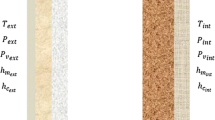Abstract
A modified one-dimensional transient hygrothermal model for multilayer wall was proposed using air humidity ratio and temperature as the driving potentials. The solution for the governing equations was obtained numerically by implementing the finite-difference scheme. To evaluate the accuracy of the model, a test system was built up to measure relative humidity and temperature within a porous wall and compare with the prediction of the model. The prediction results have good agreement with the experimental results. For the interface close to indoor side, the maximum deviation of temperature between calculated and test data is 1.87 K, and the average deviation is 0.95 K; the maximum deviation of relative humidity is 11.4%, and the average deviation is 5.7%. For the interface close to outdoor side, the maximum deviation of temperature between prediction and measurement is 1.78 K, and the average deviation is 1.1 K; the maximum deviation of relative humidity is 9.9%, and the average deviation is 4.2%.
Similar content being viewed by others
References
PHILIP J R, DEVRIES D A. Moisture movement in porous materials under temperature gradients [J]. Transactions American Geophysical Union, 1957, 38(2): 222–232.
PEDERSEN C R. Prediction of moisture transfer in building constructions [J]. Building and Environment, 1992, 33: 87–397.
KÜNZEL H M. Simultaneous heat and moisture transport in building components: One- and two-dimensional calculation using simple parameters [M]. Stuttgart: IRB Verlag, 1995: 63–69.
LUIKOV A W. Heat and mass transfer in capillary-porous bodies [M]. Oxford, U.K: Pergamon, 1966: 87–92.
CHEN You-ming, CHEN Zai-kang. The simultaneous heat and moisture transfer equations of porous building envelop and their linearization [J]. Journal of Basic Science Engineering, 1997, 5(2): 161–171.
QIN Meng-hao, BELARBI R. Development of an analytical method for simultaneous heat and moisture transfer in building materials utilizing transfer function method [J]. Journal of Material Civil Engineering, 2005, 17(5): 492–497.
BUDAIWI I., EI-DIASTY R, ABDOU A. Modelling of moisture and thermal transient behavior of multi-layer non-cavity walls [J]. Building and Environment, 1999, 34(5): 537–551.
TARIKU F, KUMARAN K, FAZIO P. Transient model for coupled heat, air and moisture transfer through multilayered porous media [J]. International Journal of Heat and Mass Transfer, 2010, 53: 3035–3044.
SANTOS G H D, MENDS N. Heat, air and moisture transfer through hollow porous blocks [J]. International Journal of Heat and Mass Transfer, 2009, 52: 2390–2398.
KUMARAN M K. IEA-Annex 24, Task 3: Material Properties [M]. Canada: IRC/NRC, 1996: 30–103.
HENS H. Heat, air and moisture transfer in insulated envelope parts. International energy agency (IEA), energy conservation in building and community systems, finial report, volume 1, task 1: Modeling [M]. IEA, Acco Leuven, 1996: 2–35.
ANDESSON A C. Verification of calculation methods for moisture transport in porous building materials [M]. Stockholm: Swedish Council for Building Research, 1985: 23–26.
American Society of Heating, Refrigerating, and Air-conditioning Engineers. ASHRAE handbook — 2005 Fundamentals. [M]. Atlanta, GA Inc, 2005: 198–202.
PEI Qing-qing, CHEN Zai-kang. An experimental study on isothermal moisture absorption and desorption processes of some common-used building materials [J]. Journal of Hunan University: Natural Science, 1999, 26(4): 96–99. (in Chinese)
LI Kui-shan, ZHANG Xu, GAO Jun. Experimental investigation of hygrothermal parameters of building materials under isothermal conditions [J]. Journal of Building Physics, 2009, 32(4): 355–370.
LAM J C, LI D H W. Correlation between global solar radiation and its direct and diffusion components [J]. Building and Environment, 1996, 31(6): 527–535.
Author information
Authors and Affiliations
Corresponding author
Additional information
Foundation item: Project(51078127) supported by the National Natural Science Foundation of China; Project(JJ201109091631) supported by the Foundation for Young Scientists of Jiangxi Education Department, China
Rights and permissions
About this article
Cite this article
Guo, Xg., Chen, Ym. & Deng, Yq. Development and experimental validation of a one-dimensional dynamic hygrothermal modeling based on air humidity ratio. J. Cent. South Univ. Technol. 19, 703–708 (2012). https://doi.org/10.1007/s11771-012-1060-z
Received:
Accepted:
Published:
Issue Date:
DOI: https://doi.org/10.1007/s11771-012-1060-z




